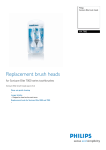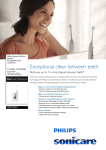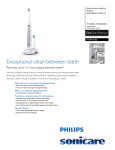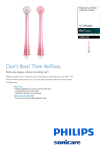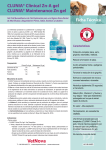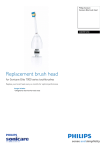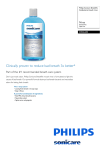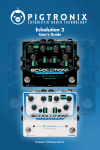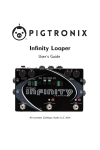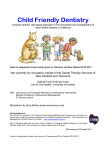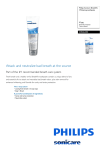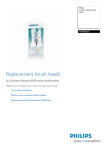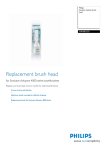Download Waterpik Technologies 7500 User's Manual
Transcript
Disclosure Statement • This course was designed, developed and produced by Waterpik Technologies • Waterpik Technologies manufactures and distributes products addressed in this course Course Objective To provide the dental team with the information and criteria needed to assist individuals in selecting a power toothbrush appropriate to need • Poor plaque (biofilm) control • Gingivitis • Periodontal maintenance • Orthodontic appliances • Implants • Aesthetic restorations • Crowns and bridges • Physically challenged • Gingival overgrowth The Best Power Brush Learning Outcomes • Discuss the clinical evidence from power toothbrush research • Identify which individuals will benefit from a power toothbrush • Recommend a power toothbrush appropriate to need Introduction Power brushes have been in existence for many years. In the past, recommendations were often reserved for those individuals with special needs. Today, with the wide variety of products on the market, almost any individual can benefit from a power brush.1 A practice-based study that included 3,669 dental professionals and 16,903 subjects demonstrates how typical dental office patients can benefit from a power brush. In the study, power toothbrush use was considered by dental professionals to have a positive effect on the oral health of 80.5% of patients. Patients agreed, with 74% stating that they thought the power brush resulted in better oral hygiene. Ninety four percent (94%) of patients reported that they would continue to use their power brush and 75% said they would recommend it to a friend.2 Power brushes are good choices for many individuals. They may be ideal devices for people who provide care to the homebound or for those institutionalized or living in a nursing home. In working with individuals, consider those who present with any of the following as prime candidates for using a power brush:3,4 2 A January 2003 systematic review5 of power brushes by the Cochrane Collaboration evaluated different types of power brushes and tried to determine the superiority of one type of brush over another. The reviewers evaluated 354 clinical trials published between 1964 and 2001. The 354 studies were reviewed for the following criteria:5 • Study design had to be a randomized, controlled trial comparing manual and power toothbrushes • Comparisons between power brushes were excluded • Crossover trials were eligible but not split mouth designs • Subjects could not have a disability that would affect toothbrushing; orthodontic appliances were allowed • Brushing had to be unsupervised • Combined interventions such as those with rinsing or irrigating were excluded • Study had to be a minimum of 28 days • Outcomes measures had to include biofilm (plaque) and gingivitis From these standards, 29 studies fulfilled all inclusion criteria and had results that could be used for meta-analysis. The total number of subjects in these trials was 2,547. Of those, 239 or 9.4% were lost to follow-up.5 The 29 trials were further categorized into groups based on the mechanism of action. Six groups resulted. These included:5 • Side-to-side action with 8 studies • Counter oscillation with 5 studies • Rotation oscillation with 11 studies • Circular with 3 studies • Ultrasonic with 2 studies • Unknown action with 0 studies From the final review, the Cochrane group determined that “Power toothbrushes with a rotational oscillation action provided slightly better plaque removal and may provide better protection against gum inflammation than manual toothbrushes.”5 The researchers discussed the weaknesses of their review and noted:5 • “One possible weakness of this review was the grouping of toothbrushes by their modes of action.” • “So many factors may influence the effectiveness of toothbrushes including filament arrangement, orientation, size, shape and flexibility, brush head size and shape along with presence or absence and characteristics of a timer that not all of them could be analyzed.” • “None of the trials compared durability, reliability, and cost of using manual versus powered brushes, it is presently not possible to make a clear recommendation on toothbrush superiority.” In summary, the Cochrane review provides important information on power toothbrushes, but is not without flaws. Of consideration is that studies on older, obsolete products with outdated technology were included in the meta-analysis.5 Many current power brushes with stateof-the-art technology have been able to show in welldesigned scientific trials that they are superior to manual brushes. 1,2,3,4,6,10,11,12 • Timer: Essential for those who need to extend brushing time • Handle size: Should be of adequate size and feel comfortable • Brush head motion and configuration: Size is important as is dexterity • Lifestyle: Frequent travelers may prefer a batteryoperated unit • Disposability: This generally means that neither the battery nor the brush head can be replaced. Products generally last around 3 months - the same as a manual toothbrush and often cost the same. May be a good gateway product • Affordability: With multiple products in a wide range of prices, there is a power brush to fit anyone’s budget Brushing Recommendations Some individuals may think that once they use a power brush, they no longer have to make any effort when brushing. Therefore, it is important to continue emphasizing how often and long to brush. Studies have shown that good biofilm removal takes time, and those who brush longer tend to remove more biofilm.8,9 Figure 1 Individual Recommendations Once clinical efficacy has been established, when recommending a power brush, individual preferences can play a significant role in product acceptance. In fact, studies have shown that when individuals play a more assertive role in healthcare decisions, compliance and satisfaction increase.6 Therefore, it is unlikely that all the individuals in a practice will like or benefit from the same type of power toothbrush. Importantly, the individual oral health needs along with personal preferences should influence the brush recommendation.1,3,6 There are a large number of power brushes on the market with a wide array of features, which can influence acceptance of the product. To help individuals find the product right for them, there are multiple features to consider. It is important to explain to first time users that power brushes have a unique or different sound and sensation than manual brushes. It may take some time to get adjusted to a new product. Additionally, some products may enhance the foaming action of the toothpaste and this may initially be overwhelming. See Figure 1. Advise individuals not to use an excessive amount of toothpaste and not to turn the unit on until they have placed the brush head in their mouth. 3 While the thoroughness of brushing is dependent on the nature of the user, power brushes may help simplify the brushing process. The individual will still need to properly angle the brush in the mouth, but once in place, the brush head motion will do all the work. Since a power brush generates more strokes per minute than a manual brush, the individual may remove more biofilm in the same amount of brushing time.3 Because there are different types of units available, be sure to review the manufacturer’s complete instruction guide PRIOR to recommending or demonstrating the product. Recommending and instructing is easier if you have read all instructions and tried the product yourself. Features include: • Gentle side-to-side vibrating brushing action • Ergonomically designed for ease and comfort • Disposable, like a manual brush. No need to replace batteries or brush heads • Internal battery lasts up to six months • Includes a handy travel brush cover • Available in four colors Figure 2 Oral Health Outcomes A toothbrush is the most frequently used self-care device. Yet the ability to effectively remove biofilm with a toothbrush varies from person to person. For the last several years, power toothbrushes have become an integral recommendation to improve biofilm control. There is a growing body of evidence on products currently available, which show when compared to a manual toothbrush, many power toothbrushes are:1,2,3,4,6,10,11,12 • Superior at removing biofilm • Effective at reducing gingivitis • Likely to enhance stain removal • As safe as a manual brush for soft and hard tissue • Well-liked and even preferred by individuals Waterpik® Power Toothbrushes Waterpik Technologies entered the power toothbrush market more than thirty years ago. From the original Touch-Tronic® toothbrush to today’s SynchroSonic™ Plus advanced action sonic plaque removal system, Waterpik® rechargeable power brushes remove biofilm and reduce bleeding better than a manual toothbrush.15,16,18 Vibe® Electric Toothbrush The Vibe® toothbrush is quiet and small enough to take everywhere. See Figure 2. Up to 15,000 brush strokes per minute clean better than a manual toothbrush.19 4 SenSonic® High Performance Sonic Plaque Remover The SenSonic® toothbrush is a brush with state-of-the-art sonic technology producing 30,000 gentle brush strokes per minute. See Figure 3. It has a soft, compact, contoured brush head design, electronic feedback system that automatically adjusts speed to maintain peak performance, a power indicator light, and a dishwasher safe, easy to clean storage carousel. Figure 3 Several clinical trials have been conducted on the SenSonic® toothbrush including studies that show its ability to alter bacteria, reduce biofilm, stain, and gingivitis, and equivalency to the Sonicare® toothbrush.13,14,15,16,17 Ability to alter bacteria • Blanco and co-workers showed that exposure to the sonic frequency generated by the SenSonic® toothbrush severely disrupted the structural integrity of the periodontal pathogen, T denticola (spirochetes).13 • MacNeill et al found that sonic energy from the SenSonic® toothbrush severely shortened and/or removed fimbriae from the cell walls of A viscosus. The researchers observed that these study findings were consistent with previous studies on other sonic brushes that have examined the effect of sonic energy on bacteria.14 Biofilm, stain, gingivitis reductions • Barnes and others demonstrated that the SenSonic® toothbrush showed statistically significant reductions in both biofilm and gingivitis after four weeks use.15 • Hefferren showed that the SenSonic® toothbrush is effective at reducing both existing stain (of one year’s duration) and that induced by diet - after just one minute of brushing.17 In a randomized clinical trial by Barnes et al, the SynchroSonic™ Plus toothbrush was significantly more effective at reducing biofilm and gingival bleeding than a manual toothbrush. There was no evidence of hard or soft tissue abrasion from the use of the SynchroSonic™ Plus 18 toothbrush. The chart below highlights the clinical outcomes from the study. Figure 4 Percent Reductions from Baseline18. Comparison to Sonicare toothbrush • Zimmer and co-workers compared a manual brush to the SenSonic® toothbrush and Sonicare® toothbrush and found both sonic brushes were more effective in removing biofilm and reducing gingivitis than the manual toothbrush.16 The chart below highlights the percent reductions from baseline for each of the brushes in the study: ® Percent Reductions from Baseline16 Sonicare® toothbrush SenSonic® toothbrush Manual toothbrush BIOFILM INDEX APPROXIMAL BIOFILM INDEX PAPILLARY BLEEDING INDEX 48.3% 52.5% 10% 74.6% 75.9% 17.4% 87.5%* 82.9%* 52.5% *Both the SenSonic® toothbrush and the Sonicare® toothbrush reduced bleeding to nearly the same level, 0.06 and 0.07 respectively. However, the Sonicare® toothbrush started with a higher baseline reading than the SenSonic® toothbrush, 0.56 versus 0.35 respectively.16 SynchroSonic™ Plus Advanced Action Sonic Plaque Remover The SyncroSonic™ Plus toothbrush is the first affordable, dual motor sonic plaque removal system. See Figure 4. With 40,000 brush strokes per minute, this dual motor design creates a unique multi-directional bristle action. The ergonomic angled design allows for better access to posterior teeth. In addition to brush heads, the system comes with a tongue cleaner and polishing attachment. The SynchroSonic™ Plus toothbrush is clinically proven superior to a manual toothbrush.18 Manual toothbrush SynchroSonic™ Plus toothbrush DENTAL GINGIVAL BIOFILM INDEX BLEEDING INDEX 5.4% 20% 9.7%* 32%* *Statistically significant18 A synopsis and comparison of other high-speed power brushes is included in the chart on page 6. When you recommend products, it is beneficial to know where they can be purchased along with an estimated cost. Having this information will enhance credibility and increase compliance with your recommendation. Alternatively, products can be purchased at professional discounts for dispensing in the office. Conclusion Power toothbrushes are safe and effective devices for many people. According to Maria Perno Goldie, RDH, MS, international speaker and author, “No longer are power toothbrushes considered only for special needs clients, but rather the logical choice for all adult and child clients. Cost is no longer an issue because prices of deluxe models are lower than ever, and low-cost battery operated portable toothbrushes are now available.” 1 5 Product Comparison: High Speed Power Brushes* Parent company Brush stroke Brush stroke per minute Speeds Timer 30 second quadrant alert Brush heads/accessories Promotional price Direct professional pricing Clinically proven better than a manual brush at reducing: • Plaque • Gingivitis/bleeding • Stain SynchroSonic™ Plus Advanced Action Sonic Plaque Removal System - Model DT 400 Waterpik Technologies Randomized (sonic) 40,000 2 2 minute Yes 2 brush heads 1 tongue cleaner 1 polisher $24.99 Yes • Yes • Yes • No Braun Oral B®3D Excel Pulsating Model - D17511 Oral-B® Laboratories Oscillation + in & out pulsation 40,000 pulsations 7,600 oscillations 2 2 minute No 1 brush head Sonicare® Elite Model 7500 Philips Oral Healthcare, Inc Sonic (back & forth) 31,000 $29.95 Yes $39.99 Yes • Yes • Yes • Yes • Yes • No • No 2 2 minute Yes 1 brush head *Information as of April 2003 Product Disclaimer All power brushes are not equivalent when it comes to brush head configuration, brush head motion, and number and type of brush strokes per minute. Therefore, expectations of similar clinical outcomes on products of differing brands cannot be assumed. References 1. Goldie MP. Power toothbrushing: An easy, effective way to improve oral health. Contemporary Oral Hygiene 2002; July/August: 28-33. 2. Warren PR et al. A practice-based study of a power toothbrush: Assessment of effectiveness and acceptance. JADA 2000; 131: 389-394. 3. Jahn C. Making patient-centered self-care recommendations: Automatic toothbrushes. J Practical Hyg 2001; 10(5): 38-39, 42. 4. Bowen D. An evidence-based review of power toothbrushes. Compend Contin Educ Oral Hyg 2002; 9: 3-16. 5. Heanue M et al. Manual versus powered toothbrushing for oral health (Cochrane Review) In: The Cochrane Library, Issue 1, 2003. Oxford: Update Software. 6. Jahn CA. Automated oral hygiene self-care devices: Making evidence-based choices to improve client outcomes. J Dent Hyg 2001; 75: 171-186. 7. Larrabee JH. The changing role of the consumer in health care quality. J Nurs Care Qual 1995; 9: 8-15. 8. Lang WP et al. Preventive behaviors as correlates of periodontal health status. J Public Health Dent 1995; 55(1): 10-17. 6 9. Hawkins BF et al. Duration of toothbrushing for effective plaque control. Quintessence Int 1986; 17: 361-365. 10. Walmsley AD. The electric toothbrush: A review. B Dent J 1997; 182: 209-218. 11. Heasman PA et al. Power toothbrushes: A review of clinical trials. J Clin Periodontol 1999; 26: 407-420. 12. Brothwell DJ et al. An update of mechanical oral hygiene practices: Evidence based recommendations for disease prevention. Can Dent Assoc J 1998; 64(4): 295-304. 13. Blanco VL et al. In vitro effect of the SenSonic® toothbrush on Treponema denticola. J Clin Periodontol 1997; 24: 318-323. 14. MacNeill S et al. Sonic and mechanical toothbrushes: An in vitro study showing altered microbial surface structures but lack of effect on viability. J Clin Periodontol 1998; 25: 988-993. 15. Barnes C. A clinical evaluation of the effect on gingivitis and plaque reduction of the SenSonic® plaque removal instrument. Abstract presented at ADHA Annual Session, 1995. 16. Zimmer S et al. Clinical study of the effectiveness of two sonic toothbrushes. J Clin Dent 1999; 11: 24-27. 17. Hefferren J et al. Assessment of the stain removal cleaning power of the SenSonic® plaque removal instrument in beagles. J Dent Res 1996; 75: 86. 18. Barnes C et al. A comparison of a Waterpik® dual motor power toothbrush and a manual toothbrush in affecting interproximal bleeding reduction and dental biofilm accumulation. J Clin Dent 2003; 14: 49-52. 19. In-house data on file. © 2003 Water Pik, Inc. PN 20007016-ART FN 20007016ART-F AA Post Test for Course #03-03 Power Brushes: An Effective Alternative 1. What features may influence individual preference for a power brush? a) Timer b) Handle size c) Brush head configuration d) All of the above 2. Which type of individual would NOT be a candidate for a power brush? a) Orthodontic b) Periodontal maintenance c) Edentulous d) Physically challenged 3. When compared to a manual toothbrush, the SynchroSonic™ Plus power toothbrush: a) Was better at removing biofilm but not at reducing gingivitis b) Was better at reducing gingivitis but not at removing biofilm c) Equal to the manual brush in biofilm removal and gingivitis reduction d) Better than the manual brush at biofilm removal and gingivitis reduction 4. When the SenSonic® toothbrush and Sonicare® toothbrush were compared to a manual toothbrush, what were the results? a) The SenSonic® toothbrush was superior in all measures to the Sonicare® toothbrush and the manual toothbrush b) The Sonicare® toothbrush was superior in all measures to the SenSonic® toothbrush and the manual toothbrush c) The SenSonic® toothbrush and Sonicare® toothbrush were both superior to the manual toothbrush d) The manual toothbrush was superior to both the SenSonic® toothbrush and Sonicare® toothbrush 5. Which statement is true about the power toothbrush review by the Cochrane Collaboration? a) One weakness of the study was grouping by modes of action b) 92 studies were included in the meta-analysis c) Randomized clinical trials were excluded d) Studies need to be a minimum of 6 months for inclusion 7 Obtaining Continuing Education Credits Waterpik Technologies is designated as an Approved PACE Program Provider by the Academy of General Dentistry. The formal continuing education programs of this provider are accepted by the AGD for Fellowship, Mastership, and membership maintenance credits. Approval does not imply acceptance by a state or provincial board of dentistry. The current term of approval extends from 04-05-1998-05-31-2006. Credits: 1 hour If you have questions about CE requirements in your state or province, please consult your regulatory board. CE Registration Form and Answer Sheet Course #03-03: Power Brushes: An Effective Alternative Name: ______________________________________ Credentials: __________________________________ Street Address: ________________________________ City: ________________________________________ State: ________________ Zip:__________________ Directions • Fill out the Waterpik CE Registration Form and Answer Sheet. • Answers should be logged on the answer sheet. Please make a copy of the post test and your answer sheet to retain for your records. • Only one original answer sheet per individual will be accepted. PHOTOCOPIES ARE NOT VALID. • Answers left blank will be graded as incorrect. • Please fill out the course evaluation portion. • Submit your answer sheet via mail to: Carol Jahn, RDH, MS Educational Programs Manager Waterpik Technologies 1730 East Prospect Road Fort Collins, CO 80553 Scoring In order to receive credit, you must answer correctly 4 questions out of 5. Results Will be mailed in 6 – 8 weeks. Questions Please contact Carol Jahn, Education Programs Manager, at 1.800.525.2020 x 8565 or via email at [email protected]. Daytime Phone: ______________________________ Email: ______________________________________ Answer Sheet - Please circle the correct answer for each question. 1. a b c d 2. a b c d 3. a b c d 4. a b c d 5. a b c d Course Evaluation – Circle your response: 1 = lowest, 5 = highest Course objectives were met 1 2 3 4 5 4 5 4 5 4 5 Content was useful 1 2 3 Questions were relevant 1 2 3 Rate the course overall 1 2 3








